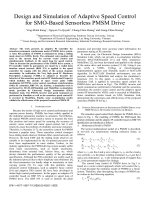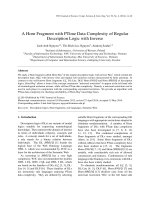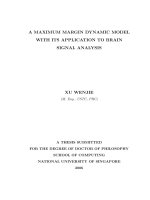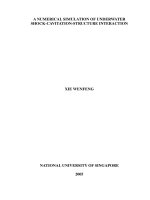Dynamic analysis with multi body simulation of articulated passenger car of AALRT
Bạn đang xem bản rút gọn của tài liệu. Xem và tải ngay bản đầy đủ của tài liệu tại đây (4.26 MB, 99 trang )
ADDIS ABABA UNIVERSITY
ADDIS ABABA INSTITUTE OF TECHNOLOGY
DEPARTMENT OF MECHANICAL & INDUSTRIAL ENGINEERING
DYNAMIC ANALYSIS WITH MULTI-BODY SIMULATION OF
ARTICULATED PASSENGER CAR OF AALRT
A Thesis submitted in partial fulfillment of the Requirements for the Degree
of Master of Science in Mechanical Engineering in Graduate Studies of
Addis Ababa University
By: BELAYHUN EJIGUALE
Advisor: Dr.Ing. DemissAlemu
July 2017
DYNAMIC ANALYSIS WITH MULTI-BODY SIMULATION OF ARTICULATED PASSENGER CAR
Declaration
I hereby declare that the work, which is being presented in this thesis entitled “Dynamic
Analysis with Multi-Body Simulation of Articulated Passenger Car of AALRT” is original
work of my own and currently happen problem in AALRT which has not been presented for a
degree of any other university and all the resource materials which mentioned in the reference
have been duly acknowledged.
Belayhun Ejiguale
________________
Signature
ADDIS ABABA INSTITUTE OF TECHNOLOGY (AAIT) July, 2017
__________
June, 2017
Page I
DYNAMIC ANALYSIS WITH MULTI-BODY SIMULATION OF ARTICULATED PASSENGER CAR
Approval sheet
ADDIS ABABA UNIVERSITY
ADDIS ABEBA INSTITUTE OF TECHNOLOGY
SCHOOL OF MECHANICAL AND INDUSTRIAL ENGINEERING
Title:
Dynamic Analysis with Multi-Body Simulation of Articulated passenger car of AALRT
By
Belayhun Ejiguale
July, 2017
Approved by Board of Examiners:
Dr.Ing. DemissAlemu
Advisor
_____________________
Internal Examiner
_____________________
External Examiner
_____________________
Railway Center Head
______________
_____________
Signature
Date
______________
______________
Signature
Date
_____________
______________
Signature
Date
_____________
_____________
Signature
Date
ADDIS ABABA INSTITUTE OF TECHNOLOGY (AAIT) July, 2017
Page II
DYNAMIC ANALYSIS WITH MULTI-BODY SIMULATION OF ARTICULATED PASSENGER CAR
Acknowledgement
First of all I would like to express heartfelt sincere gratitude to my advisor D.r Ing. Demis
Alemu next to God for his follow up, guide, invaluable advice and technical support in
strengthening during the course of my paper work. In fact, this thesis would not have come in
its present form without his proper follow up in reshaping and organizing of ideas.
Secondly, I would like to express heartfelt thanks for progress examiners such as ato Arya and
ato Hiredin to give fruit full comments, sharing ideas to address the stated problem. Thirdly I
would like to thank Ethiopian Railway Corporation (ERC) kality depot administration and
technicians for their appreciable help and technical support and AAIT and all stuff of
Department of Mechanical and Industrial Engineering because of their great support in
completing this paper.
Fourthly, I would like to acknowledge, Addis Ababa University& Ethiopian Railway
Corporation for giving to me the chance to study masters of degree and their kindness and help
during those academic years.
Lastly but not the least I would like to thank my wife and my friends Tesfaye Atalay and Dula
Fkadu for their encouragement, and support with different materials and ideas. Without their
guidance, help and patience, I would have never been able to accomplish the work of this paper.
ADDIS ABABA INSTITUTE OF TECHNOLOGY (AAIT) July, 2017
Page III
DYNAMIC ANALYSIS WITH MULTI-BODY SIMULATION OF ARTICULATED PASSENGER CAR
Abstract
The railway vehicle running along a track is one of the most complex dynamic systems in
railway engineering and it has many degree of freedom, the interaction `between wheel and rail,
suspension and articulation systems involves complex systems. However, thevehicle body
lowering down to the rail at maximum load condition was critical issue for the corporation. To
identify the stated problem, dynamic analysis with multi-body simulation of articulated
passenger car is crucial by SIMACK MBS software package. The 3D modeling and the
simulation process pass through three steps by using this multi-body simulation software
package. The Simulation results were the predictions of vertical deformation of railway vehicle
suspension and articulations on straight and curved track can be made. The primary suspension,
secondary suspension and articulation systems vertical deformation were 5.25mm, 15.125mm,
and 12.35mm in straight track and 17.125mm, 40mm and 22.125mm in curved track. In order to
withstand the vehicle body lowering down problem, vertical primary and secondary suspension
stiffness and damping value optimized. After optimization the primary and secondary
suspension and articulation system vertical deformations were 15.975, 20.325 and 16.375mm.
Therefore, the vertical suspension and articulation systems, maximum vehicle load, minimum
track curve radius and wheel diameter variation have great effect for the current problem. To
withstand this problem, the vertical suspension stiffness and damping value have to be
optimized.
Key words: dynamic analysis, multi-body simulation, simpack, articulation, suspension, 3D model,
simulation
ADDIS ABABA INSTITUTE OF TECHNOLOGY (AAIT) July, 2017
Page IV
DYNAMIC ANALYSIS WITH MULTI-BODY SIMULATION OF ARTICULATED PASSENGER CAR
Table of Contents
Declaration .............................................................................................................................................. I
Approval sheet ........................................................................................................................................ II
Acknowledgement ................................................................................................................................ III
Abstract ................................................................................................................................................ IV
List of table ........................................................................................................................................ VIII
List of figure ......................................................................................................................................... IX
CHAPTER ONE..................................................................................................................................... 1
1.1 General Introduction .................................................................................................................... 1
1.2. Hypothesis .................................................................................................................................. 2
1.3. Problem Statement ...................................................................................................................... 3
1.4. Objectives ................................................................................................................................... 4
1.4.1 General objective ................................................................................................................. 4
1.4.2 Specific Objective ................................................................................................................ 4
1.5. Methodology ............................................................................................................................... 5
1.6. Software Validation .................................................................................................................... 7
1.7. Scope or Delimitations ............................................................................................................. 10
1.8. Significance of the Study .......................................................................................................... 10
1.9. Thesis organization ................................................................................................................... 11
CHAPTER TWO: LITERATURE REVIEW ...................................................................................... 12
2.1. General review of railway dynamics ........................................................................................ 12
2.2. Articulated passenger Vehicle on straight track ....................................................................... 12
2.3. Articulated passenger vehicles on Curved track ....................................................................... 13
2.4. Related literature review about the stated problem .................................................................. 15
CHAPTER THREE .............................................................................................................................. 17
ADDIS ABABA INSTITUTE OF TECHNOLOGY (AAIT) July, 2017
Page V
DYNAMIC ANALYSIS WITH MULTI-BODY SIMULATION OF ARTICULATED PASSENGER CAR
3.1 Dynamic analysis of passenger railway vehicles....................................................................... 17
3.2. DOF for the three bogie passenger rail vehicle ........................................................................ 20
3.3. Passenger railway vehicles Lateral dynamics ........................................................................... 21
3.4. Passenger railway vehicle Vertical dynamics: ......................................................................... 22
3.4.1. Mathematical modeling of the equation of motion along lateral, vertical and pitch
direction ...................................................................................................................................... 23
3.4.2. Vertical suspension of the three bogie passenger vehicle vertical dynamics.................... 24
3.5. Data entry for the Multi-Body software ................................................................................... 26
3.5.1 Load parameter .................................................................................................................. 26
3.6. 3D modeling of articulated passenger rail vehicle ................................................................... 27
CHAPTER FOUR ................................................................................................................................ 35
4.1. Multi-body simulation .............................................................................................................. 35
4.2. Hunting State Analysis ............................................................................................................. 36
4.3. Dynamic simulation on straight track ....................................................................................... 39
4.4. Dynamic simulation on curved track ........................................................................................ 45
4.5. Parameter variation result ......................................................................................................... 56
4.6. Dynamic performance Evaluation ............................................................................................ 61
4.6.1 Ride index .......................................................................................................................... 61
4.6.2 Derailment coefficient........................................................................................................ 63
CHAPTER FIVE .................................................................................................................................. 64
5.1. Result Discussion...................................................................................................................... 64
5.2. Conclusion ................................................................................................................................ 67
5.3. Recommendation ...................................................................................................................... 68
5.4. Future Work .............................................................................................................................. 69
Reference .............................................................................................................................................. 70
ADDIS ABABA INSTITUTE OF TECHNOLOGY (AAIT) July, 2017
Page VI
DYNAMIC ANALYSIS WITH MULTI-BODY SIMULATION OF ARTICULATED PASSENGER CAR
Appendix .............................................................................................................................................. 73
Appendix. A. some input data for the MBS software package ....................................................... 73
Appendix. B. Some MBS information ............................................................................................ 75
Appendix. C. Some simulation results ............................................................................................ 79
ADDIS ABABA INSTITUTE OF TECHNOLOGY (AAIT) July, 2017
Page VII
DYNAMIC ANALYSIS WITH MULTI-BODY SIMULATION OF ARTICULATED PASSENGER CAR
List of table
Table 1. Degree of freedom of articulated passenger rail vehicle ........................................................ 20
Table 2. Dynamic simulation condition and Expected Dynamic simulation out put ........................... 35
Table 3. Vertical primary and secondary suspension stiffness value ................................................... 61
Table 4. Simulation result and validation criteria ................................................................................ 65
Table 5. Load parameter ....................................................................................................................... 73
Table 6. Basic parameter ...................................................................................................................... 73
Table 7. Standard values of ride index ................................................................................................. 74
ADDIS ABABA INSTITUTE OF TECHNOLOGY (AAIT) July, 2017
Page VIII
DYNAMIC ANALYSIS WITH MULTI-BODY SIMULATION OF ARTICULATED PASSENGER CAR
List of figure
Figure 1. Side and top view reperesentation of passenger vehicles ....................................................... 1
Figure 2. Gangway system folding bellows lower dawon to the rail. .................................................... 2
Figure 3. Vehicle body Lowering down and damaging of balliec from sleeper and damaging itself ... 3
Figure 4. Methodology justification ....................................................................................................... 6
Figure 5. Simpack AALRT passenger vehicle model algorism ............................................................. 9
Figure 6. The kinematic oscillation of a wheel set [2, 3]. .................................................................... 13
Figure 7. (a) In central position, (b) in laterally displaced position and flange rail contact [2] (c)
Lateral and vertical motion of wheel set [7]......................................................................................... 13
Figure 8. (A) Curved tack, (B) Geometry of a coned wheel set on a gentle curve (C) Vehicle curving
effect on vertical suspensions [3, 7] ..................................................................................................... 14
Figure 9. Railcar force diagram on a super elevated curve [3]. ........................................................... 14
Figure 10. Main components of passenger vehicles system components ............................................ 18
Figure 11. Schematic diagram of passenger rail vehicle ...................................................................... 19
Figure 12. Degree of freedom (a) by figure and (b) by table ............................................................... 21
Figure 13. Degree of freedome along lateral direction ........................................................................ 22
Figure 14. Vertical dynamic degree of freedome ................................................................................. 22
Figure 15. Vertical primary and secondary suspension[20] ................................................................. 25
Figure 16. The six wheels including axles ........................................................................................... 27
Figure 17. Wheel sets, axle boxes and bogie frames............................................................................ 28
Figure 18. Motor and Trailer Bogie frame ........................................................................................... 28
Figure 19. Fixed lower articulations, upper flexible and free articulations and dampers .................... 30
Figure 20. The two side lower and upper articulations and car body-B including middle bogie ........ 31
Figure 21. Model of car body including marker points ........................................................................ 32
Figure 22. Front, side and top view of car body................................................................................... 33
Figure 23. The 3D model of vehicle on curved track ........................................................................... 34
Figure 24. The six wheels set hunting state result under the stated condition ..................................... 37
Figure 25. The three bogies and the three car body module hunting state result ................................. 38
Figure 26. Bogie one Primary suspension on straight track in z-direction .......................................... 39
Figure 27. Middle bogie Primary suspensions on straight track in z-direction .................................... 40
ADDIS ABABA INSTITUTE OF TECHNOLOGY (AAIT) July, 2017
Page IX
DYNAMIC ANALYSIS WITH MULTI-BODY SIMULATION OF ARTICULATED PASSENGER CAR
Figure 28. Third bogie primary suspension vertical flexibility ............................................................ 41
Figure 29. Bogie 1 secondary suspension vertical deflection in z-direction ........................................ 42
Figure 30. Bogie 2 front and rear secondary suspension in z-direction ............................................... 42
Figure 31. Bogie 3 front and rear secondary suspension in z-direction ............................................... 43
Figure 32. For each bogie secondary damping in z-direction .............................................................. 43
Figure 33. Fixed articulation vertical displacement in z-direction ....................................................... 44
Figure 34. Car body and bogie vertical displacement .......................................................................... 45
Figure 35. Bogie one primary suspension on curved track .................................................................. 46
Figure 36. Bogie two primary suspensions on curved track ................................................................ 46
Figure 37. Bogie three primary suspensions on curved track .............................................................. 47
Figure 38. Bogie one and two secondary suspension in curved track .................................................. 47
Figure 39. Bogie two secondary suspensions ....................................................................................... 48
Figure 40. Bogie three secondary suspensions in curved track ............................................................ 48
Figure 41. Bogie 1, 2 and 3 primary and secondary suspension vertical deflection deviation ............ 49
Figure 42. Each bogie frame and each car body module vertical deflection at the stated condition ... 50
Figure 43. Front and rear articulation vertical displacement ................................................................ 51
Figure 44. Car body lateral and vertical acceleration ........................................................................... 52
Figure 45. Lateral wheel shift force and Vertical force on leading wheel set ...................................... 53
Figure 46. After optimization the primary and secondary suspension vertical deflections ................. 54
Figure 47. After suspension stiffness value optimization bogie and car body vertical deflections ..... 55
Figure 48. After suspension optimization lower fixed articulation front and rear vertical deflection . 56
Figure 49. Vehicle mass effect on vertical suspension ........................................................................ 57
Figure 50. Wheel diameter variation effect on vehicle vertical position ............................................. 58
Figure 51. Critical speed variation on lateral and vertical position...................................................... 59
Figure 52. Primary suspension stiffness and damping value optimizations......................................... 60
Figure 53. Secondary suspension stiffness and damping value optimizations..................................... 60
Figure 54. Ride index of each car body module ................................................................................... 62
Figure 55. After suspension optimization each car body ride index .................................................... 62
Figure 56. Derailment coefficient of leading wheel set ....................................................................... 63
Figure 57. Vehicle body coupling system information ........................................................................ 75
Figure 58. Vehicle body marker point and system component ............................................................ 76
ADDIS ABABA INSTITUTE OF TECHNOLOGY (AAIT) July, 2017
Page X
DYNAMIC ANALYSIS WITH MULTI-BODY SIMULATION OF ARTICULATED PASSENGER CAR
Figure 59. Constraint point and system component ............................................................................. 77
Figure 60. Addis Ababa Light Rail transient substations ..................................................................... 78
Figure 61. Wheel set lateral and vertical displacement ........................................................................ 79
Figure 62. Derailment coefficient of wheel set left and right wheels .................................................. 80
Figure 63. Lateral track excitation for each wheel set ......................................................................... 81
Figure 64. Vertical track excitation on each wheel set ......................................................................... 82
Figure 65. Track cross over excitation on each wheel set .................................................................... 83
Figure 66. Design parameters for forces and accelerations [33] .......................................................... 84
Figure 67. Measurement record list and standards ............................................................................... 85
ADDIS ABABA INSTITUTE OF TECHNOLOGY (AAIT) July, 2017
Page XI
DYNAMIC ANALYSIS WITH MULTI-BODY SIMULATION OF ARTICULATED PASSENGER CAR
Symbols and Abbreviation
MBS……………………………………………………….Multi-body-simulation
AALRT………………………………………………….Addis Ababa Light Rail Train
DOF……………………………………………………….Degree-of-freedom
3D………………………………………………………….Three dimensional
FMS……………………………………………………….. Flexible multi-body system
Mc, Mb, Mw ……………………………………….…..……Mass of car body, bogie, wheel set
MDOF…………………………………………………….. Multiple-Degree of-Freedom
X, Y, Z. ………………………..…... Longitudinal, lateral, vertical directions
Ø, β, Ψ……....................................... Roll (x-rot), pitch (y-rot), and yaw (z-rot) positive, right
hand rule
Ẍ, Ÿ, Ẑ …………………….………Acceleration along longitudinal, lateral, vertical direction
FyAB,FyBC…………………………... Internal forces of car body articulations lateral direction
FzAB, FzBC……………………….…..Internal forces of car body articulations vertical direction
FyA, FyB, FyC..................................... Mutual forces of car body along lateral direction
FzcA, FzcB, FzcC……………….……. Mutual forces of car body along vertical direction
g……………………………………Gravitational acceleration
Φseci………………………………... Car body deflection along lateral direction
Fxccpi, Fycpi, Fzccpi…………………….External excitation forces
Ix, Iy, Iz………………………….Movements of inertia of car body
MyA, MyB, MyC…………….…. Mutual movements of car body lateral directions
MzA, MzB, MzC……………….. Mutual movements of car body vertical directions
MyAB, MyBC, MzAB, MzBC ……..Internal movements of articulations along y and z
ADDIS ABABA INSTITUTE OF TECHNOLOGY (AAIT) July, 2017
directions
Page XII
DYNAMIC ANALYSIS WITH MULTI-BODY SIMULATION OF ARTICULATED PASSENGER CAR
Mxcpi, Myccpi, Mzccpi…………….……. External excitation movements of car body
Iyb, Izb……………………………..… Movements of inertia bogie along x, y, z directions
Fys1, Fys2, Fys3, FzbA, FzbB, FzbC………Mutual forces of car body along y and z directions
Fy1, Fy2, Fy3, Fy4, Fy5, Fy6, Fzw1, Fzw2, Fzw3, Fzw4, Fzw5, Fzw.......Internal forces between bogies and
wheel sets along y and z directions
Myb1, Myb2, Myb3, Mzbmf1, Mzbmf2,Mzbmf3 ……….Mutual movements of bogies along y, z
directions
Myw1, Myw2, Myw3, Myw4, Myw5, Myw6, Mzw1, Mzw2, Mzw3, Mzw4 ,Mzw5,Mzw6...……Internal
movements between bogies and wheel sets.
Fxbcpi, Fycbi, Fzbcpi…………………... External excitation forces along y, z directions
Mybcpi, Mzbcpi …………………..….. External excitation forces and movement along
Iyw, Izw………………………………Movements of inertia along y, z directions
Øw, βw, Ψw…………………………. Angular acceleration of wheel sets along y, z directions
Fywmi, Fzmwi……………………..…..Mutual forces of wheel sets along y, z directions
Mywmfi, Mzwmfi…………..………… Mutual movements of wheel sets along y, z directions
Fywcfi, Fzcfwi…………….…………...Contact forces of wheel sets
Fxwcpi, Fywcpi, Fzwcpi…………..…..... External excitation forces of wheel sets
Mywcfi, Mzwcfi…………….....…..Contact movements of wheel set
Mxwcpi, Mywcpi, Mzwcpi……….……External excitation movements of wheel sets
C1, C2, K1 and K2 ……………...Damping and stiffness of primary and secondary suspension
ADDIS ABABA INSTITUTE OF TECHNOLOGY (AAIT) July, 2017
Page XIII
DYNAMIC ANALYSIS WITH MULTI-BODY SIMULATION OF ARTICULATED PASSENGER CAR
CHAPTER ONE
1.1 General Introduction
Along the historical development of transportation system, rail transport dates back nearly 500 years and
includes systems with man or horse power and rail of wood or stone [2]. These railroad transportations are
the most safe, fast, mass transportations, high income generation, environmentally friendly and widely used
methods of transporting passengers and goods in the world. Due to these and other advantages, Ethiopia
Railway Corporation received 70% low floor rail vehicles with 3 body modules and 3 bogies (2 motor
bogies and 1 trailer bogie) from Changchun Railway Vehicles co. Ltd [1] as shown in the following
figure.
Figure 1. Side and top view reperesentation of passenger vehicles
This vehicle running along a track is one of the most complex dynamic systems in railway
engineering and it has many degrees of freedom, the interaction between wheel and rail involves
both complex geometry of wheel tread and rail head [2]. However, this vehicle body lowering
down to the rail and damage the gangway and ballice were taken while the peak time of operation.
The following figure shows currently occurred problem.
ADDIS ABABA INSTITUTE OF TECHNOLOGY (AAIT) July, 2017
Page 1
DYNAMIC ANALYSIS WITH MULTI-BODY SIMULATION OF ARTICULATED PASSENGER CAR
Figure 2. Gangway system folding bellows lower dawon to the rail.
This vehicle body lowering down problem is more related to vertical suspension system
deformation, wheel diameter variation, maximum vehicle load effect and articulation folding
bellow attachments. To solve the stated problem, they used 10mm washer for the secondary
suspension systems to keep the acceptable height from top of rail but while increasing the number
of washer to get the allowable height, additional problem occures for the secondary spring
suspension suport.The previous research’s, journals and text books studied two bogie railway
vehicles. The stated problem occurs on three bogies with three car body modules by connecting
articulation systems. So that, the three bogies and the three car body module articulated passenger
vehicles at maximum vehicle load, wheel diameter difference, critical speed and vertical
suspension stiffness values are not studied. The overall components, force elements, rigid and
flexible bodies need multi-body simulation technique to address the objective of the research.
1.2. Hypothesis
The vehicle body lowering down problem may arise fromvertical deformation of primary and
secondary suspension systems, flexiblity of articulation systems, vertical flexibility of connecting
systems, variation of wheel set lateral movement, maximum passengers load, the loosen tight of
the rope attachment of folleding belows and the rapid wear of wheel flangeto lead the lowering
down of vehicle body to the rail. Increasing the number of washers lead for secondary suspension
minimum suport may cause for high risk of deriliment, while the vehicle running along the curved
track with maximum passenger load.Based on the fact that, the vertical suspension deformation,
maximum load, wheel diameter variations and articulation systems take the great role for the stated
problem. Therefore, dynamic analysis with multi-body simulation by using SIMPACK is crucial.
ADDIS ABABA INSTITUTE OF TECHNOLOGY (AAIT) July, 2017
Page 2
DYNAMIC ANALYSIS WITH MULTI-BODY SIMULATION OF ARTICULATED PASSENGER CAR
1.3. Problem Statement
Railway vehicles running along two guided rail is one of the most complex dynamic systems and it
has many degrees of freedom and difficulties to solve dynamic problem. The non-conservative
forces generated by relative motion in the contact area and there are many non-linearity’s between
wheel and rail, primary and secondary suspension on the car body and articulation systems. In
addition to that, these vehicles running along a minimum curve radius also generate additional
difficulty. Due to this and other reasons AALRT passenger rail vehicle body was lowering down to
the rail and damage the gangway and ballice while the peak time of operation was taking place
before reaching the acceptable limit of wheel diameter. For detail understanding of the problem,
see the following figure 3.
Figure 3. Vehicle body Lowering down and damaging of balliec from sleeper and damaging itself
This figure collected from the problem faced vehicle. For the lower right on the figure is that, they used
to minimize the lowering down problem.
ADDIS ABABA INSTITUTE OF TECHNOLOGY (AAIT) July, 2017
Page 3
DYNAMIC ANALYSIS WITH MULTI-BODY SIMULATION OF ARTICULATED PASSENGER CAR
1.4. Objectives
1.4.1 General objective
The general objective of this research paper is devoted to dynamic analysis with multi-body
simulation of articulated passenger car of AALRT by SIMPACK software package.
1.4.2 Specific Objective
Determine the vertical deformation of primary and secondary suspension at maximum
vehicle load in strait and curved track condition
Determine fixed lower front and rear articulation vertical deformation in straight and
curved track condition.
Determining the vehicle mass variation on vehicle body vertical deformation under
parameter variation condition.
Showing the effect of wheel radius variation on vehicle body vertical deformation.
Determine the effect of lateral displacement of wheel set on vehicle body vertical
deformation.
To determine the car body and bogie vertical deformation while maximum load conditions.
Determine the dynamic performance analysis on minimum horizontal curved track
conditions
ADDIS ABABA INSTITUTE OF TECHNOLOGY (AAIT) July, 2017
Page 4
DYNAMIC ANALYSIS WITH MULTI-BODY SIMULATION OF ARTICULATED PASSENGER CAR
1.5. Methodology
In order to identify the stated problem, dynamic analysis and multi-body simulation of articulated
passenger car of AALRT by using SIMPACK Multi-Body Simulation software package have been
carried out. Therefore, the methodology to address the stated problem as follows.
Stating the function of vertical primary and secondary suspension which supporting vehicle
body.
SIMPACK 3D model made based on six DOF but modeling the governing equation of
motion were made for vertical, lateral and pitching dynamics based on three DOF.
3D modeling of the AALRT by using SIMPACK MBS software for each component and
assembled the full car body module.
Simulating this model under the following main parameter simulation technique for which
affect the stated problem:
Primary and secondary vertical suspensions stiffness and damping value.
Mass of vehicle load for maximum conditions.
Wheel diameter from new wheel(660mm) to lower limit of (595mm)
Critical speed variation
ADDIS ABABA INSTITUTE OF TECHNOLOGY (AAIT) July, 2017
Page 5
DYNAMIC ANALYSIS WITH MULTI-BODY SIMULATION OF ARTICULATED PASSENGER CAR
Input parameter and Dimension
3D Modeling
Currently used Stiffness and
damping value
Mass of Vehicle Load
variation
SIMPACK
MBS
Critical Speed variation
Wheel diameter variation
Cause identification for the stated problem
Primary and secondary vertical suspension
stiffness value optimization
Figure 4. Methodology justification
This paper uses to achieve the objective of the dynamic analysis with multi-body simulation of
passenger car of AALRT to identify the current problem by using AALRT data. The area of this paper
mainly focuses on AALRT project to identify the lowering of the vehicle body and the articulation
folding bellows towards the rail.
ADDIS ABABA INSTITUTE OF TECHNOLOGY (AAIT) July, 2017
Page 6
DYNAMIC ANALYSIS WITH MULTI-BODY SIMULATION OF ARTICULATED PASSENGER CAR
1.6. Software Validation
There are modeling and dynamic analyses programs that have received wide acceptance in recent
years include [20]:
NUCARS
MEDYNA
VAMPIRE
SIMPACK
ADAMS/RAIL
GENSIS
Although the above programs have different attributes, they were all developed specifically for
railway vehicle dynamic modeling and simulations [20]. Each program includes different solution
methodology, wheel/rail models, analysis methods and user interface. Among those software, we
had get training on SIMPACK MBS software and in addition to had got the training it has the
following advantages. It is a general Multi-Body Simulation Software used to model the dynamic
behavior of interconnected rigid or flexible bodies that are subjected to translational, rotational and
displacements [20]. While single bodies or parts of a mechanical system are studied in detail with
finite element methods, the behavior of the whole Multi-Body systems are studied with MultiBody Systems and this enables engineers to generate and solve virtual 3D models in order to
predict and visualize motion, coupling forces and stresses [20]. The main advantage of this
software is that it is adapted to full transient non-linear analyses, even within the acoustic range,
being particularly outstanding in transient high frequency analysis [20].Due to this and others
important features, SIMPACK- MBS software package is used to achieve the objective of the
research.
ADDIS ABABA INSTITUTE OF TECHNOLOGY (AAIT) July, 2017
Page 7
DYNAMIC ANALYSIS WITH MULTI-BODY SIMULATION OF ARTICULATED PASSENGER CAR
Building the passenger railway vehicle model by SIMPACK graphical user interface and
realization of the simulation is achieved by following three main steps [20]:
A) Pre-Processing
B) Processing
C) Post-Processing
Based on this paper, the following process is explained separately:
A. The pre-processing module is used for building the MBS together with its corresponding3D
geometry. Some of the available features from this menu are as follows; Open Model, Model
set up, MBS Define body, MBS Define Joint, Define constraints, Force Elements, Define
sensor, vehicle global, track definition, information, element menu and so on. In this MBS
model window, each body mass, center of mass, movement of inertia, marker point, joint
state, DOF, force element, force type, speed, track and wheel type, track irregularities and
other important criteria’s were justified.
B. The processing module mostly contains calculations and parameter variation process to
allow the user to configure and perform different calculations and Para variation process.
Assemble System, Nominal Force Parameters, Eigenvalues, Time Integration and
Measurements, perform time domain, kinematic, Eigen frequency, critical
C. The post-processing step deals with the final result plotting and extracted data from the
simulation. The SIMPACK program offers detailed results for each body forming the multibody model in the railway vehicle. The output shows the Para variation time domain 2D
plots, G2D plots and state plot.
SIMPACK allows the results of calculations to be animated in 3D in either the SIMPACK Post
Processor or the 3D Model Setup window.
ADDIS ABABA INSTITUTE OF TECHNOLOGY (AAIT) July, 2017
Page 8
DYNAMIC ANALYSIS WITH MULTI-BODY SIMULATION OF ARTICULATED PASSENGER CAR
Figure 5. Simpack AALRT passenger vehicle model algorism
ADDIS ABABA INSTITUTE OF TECHNOLOGY (AAIT) July, 2017
Page 9
DYNAMIC ANALYSIS WITH MULTI-BODY SIMULATION OF ARTICULATED PASSENGER CAR
1.7. Scope or Delimitations
The passenger railway vehicles running along a track is one of the most complex dynamic systems
in railway engineering. Therefore, this paper mainly focuses on the dynamic analysis with multibody simulation of AALRT passenger car to identify the lowering down of the car body. The
following points may be considered:
The three car body module and the three bogie frame are considered as rigid body frame.
Designing of folding bellows is not included
Wire rope attachment is not included
Simulation by using secondary suspension spring washer is not included
Track flexibility and Track irregularity are considered for external excitation, because track
flexibility and irregularity are not avoided. Forces which generated by centrifugal and
centripetal effect while vehicle passes through curved tracks are considered.
Track super elevation and curving effect are considered.
Effect of wind, aerodynamics and braking are not taken in to account in the current study
but they do influence on the rail vehicle vertical dynamics.
1.8. Significance of the Study
The major merits of the study energies the railway academy future research center to investigate
the real cause of the vehicle body lowering down problem. Since the cause of the stated problem
very vast, this study focus on the vertical deformation of primary and secondary suspension and
articulation systems in straight and curved track condition by using fully assembled three bogie
passenger car body modules by using SIMPACK MBS software package to get detail solution.
This helps to identify the stated problem and make the right decision for further researchers.
ADDIS ABABA INSTITUTE OF TECHNOLOGY (AAIT) July, 2017
Page 10
DYNAMIC ANALYSIS WITH MULTI-BODY SIMULATION OF ARTICULATED PASSENGER CAR
1.9. Thesis organization
The chapter of this paper organized to guide the reader from theoretical background to final results.
Chapter two reviews about the dynamic analysis of articulated passenger vehicles, lateral displacement
of railway vehicles, vertical displacements, curve negotiation of railway vehicles and curved supper
elevation track. Chapter three provide general concept about railway dynamics, articulated passenger
car system components and joints, degrees of freedom, theoretical concept and mathematical modeling
of lateral, vertical, pitching and vertical suspension systems. And also states the specification, standards
and dimensions of passenger railway vehicles, 3D modeling of system components of vehicle body parts
and fully assembled body. Chapter four provides the simulation of the 3D modeling according to the
methodology and parameter variation technique carried out. The result of those simulations presented
accordingly. Chapter five states the result discussion, validation, recommendation, future work and the
conclusion of the whole results of the simulation.
ADDIS ABABA INSTITUTE OF TECHNOLOGY (AAIT) July, 2017
Page 11









